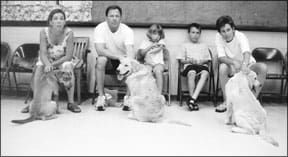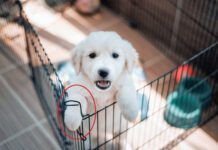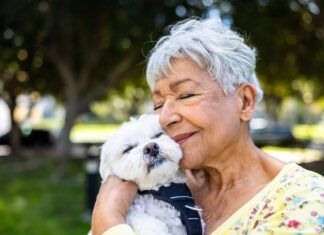What’s the best age to start training? For most puppy owners, the answer is “Yesterday!” In fact, the optimum time to start a puppy’s education is as early as possible: about eight weeks of age. It’s hard to fathom that at one time many trainers insisted that puppies be at least six months old in order to enroll in a training class. Today’s positive trainer – and educated, progressive veterinarian – knows that the first four months of your dog’s life are the most important time for socialization, to lay the foundation for learning that will serve him (and you) for the rest of his life.
Of course, in “those” days we all trained with choke chains, using solid yanks on the leash (“corrections”) to get our training message across. And because choke chains can damage (or even collapse) a dog’s trachea, trainers were wise not to inflict that harsh punishment on the tender throats of eight-week-old puppies.
Today, with food treats and clickers as the primary tools in our training arsenal, puppy tracheas are safe, and we can help owners start educating their youngsters at a much more optimum training age, before pups have had several months of reinforcement for unwelcome and inappropriate behaviors.
Paradoxically, some veterinarians still counsel owners to wait until their new puppies are six months old and “fully vaccinated” to take them to training class. Unfortunately, this advice is just as outdated as the use of choke chains in puppy classes!
It’s true that you shouldn’t want only to expose your pup to high-risk dog populations; you should never take him to a dog park, or let him play with stray dogs on the street. But the risk of contracting an infectious disease in a controlled setting, with other healthy puppies, is quite low. In fact, there is probably a much greater risk of a dog meeting a tragic end due to behavior problems from lack of early training and socialization than from exposure in a well-run puppy class to some deadly disease.
The well-run puppy class
The caveat is that you find a “well-run” puppy class. You want an experienced trainer who uses gentle, effective training methods on her human clients as well as the dogs, and who conducts her classes in a safe and clean environment. She should have a good understanding of dog body language and social behavior, and know when to intervene if a puppy is being inappropriate with his playmates. She should also have knowledge of puppy diseases and parasites and require presentation of health records upon registration for class.
Ideally, you’ll find an instructor who teaches good manners behaviors in her puppy classes as well as providing puppy socialization (play!) time, and who will also address questions you may have about other topics, such as housetraining, crating, and puppy biting.
Sadly, there are still plenty of old-fashioned trainers who are apt to administer a physical correction to your puppy for perceived transgressions. Avoid those trainers at all costs. These trainers may call themselves positive, and in fact may be more positive than they used to be, but if they still use leash corrections, loud verbal reprimands, any kind of physical punishment, or restraints such as pinning a puppy on his side, they’re not positive enough!
You can find trainers from a variety of sources: the phone book, referrals from dog-owner friends or your veterinarian, dog clubs, business cards on pet supply store bulletin boards, the Internet . . . and any of these might be great – or not. (See “Internet Resources for Finding a Trainer,” below.) To be on the safe side, arrange to sit in on a class or two and watch the trainer in action. If the trainer doesn’t allow this, find another trainer.
When you are watching a prospective training class, look for these things:
• The trainer appears friendly, confident, and competent.
• She allows time for questions, and answers them willingly and thoroughly.
• Canine and human students appear to be learning, enjoying themselves, and succeeding at assigned exercises.
• Students receive individual attention and coaching.
• There is adequate concern for dog and human health and safety. The facility is clean, with no strong odors, and the floors have non-slip footing.
• The environment is well controlled to promote calm – no running children, loose dogs (except during playtime), loud noises, excessive barking, etc.
• Dogs are handled gently – without physical force, punishment, strong verbal reprimands, or forcible restraint of a struggling or vocalizing puppy.
• Trainer doesn’t do or require owners to do anything that conflicts with the owner’s training and dog handling philosophies.
• During playtime, puppies are separated into appropriate playgroups where they are closely monitored and inappropriate play is interrupted.
• The trainer is respectful of dog and owner individual needs and training goals.
What to expect
You’ve researched and selected the right class for your pup. If you’ve watched a class or two in session, you already have some idea of what to expect from the trainer you’ve chosen. What you encounter in the actual classes you’ve signed up for will vary, depending on the trainer’s or training school’s puppy class curriculum.
Some puppy classes focus primarily on socialization. A good part of the class may be dedicated to puppy play, with other activities included. A trainer might have owners encourage their pups to encounter new surfaces – walking across a board on the ground, stepping through scattered hula hoops, crossing a blanket, a box filled with sand or gravel, or a crinkly substance like aluminum foil.
There might be some time spent with gentle restraint, helping puppies learn that being held makes good things happen, and playing “pass-the-puppy” so baby dogs have good experiences meeting a variety of people. Pups might come nose-to-nose with nail clippers, hair dryers, vacuum cleaners, crutches, and other real-life potentially scary stimuli for the first time. Puppies aren’t forced, of course, but rather given a positive association with all these things, and are reinforced for any willingness to be brave.
Other classes may have a stronger emphasis on actual training. Since 8-week-old puppies are perfectly capable of learning all the behaviors that older dogs do, there is huge value in teaching them what to do at an early age, well before they have a long history of practicing and being reinforced for behaviors you want them not to do.
Some training schools offer both. Legacy Canine Behavior and Training in Sequim, Washington, is operated by longtime positive trainer Terry Ryan. Legacy’s Puppy HeadStart class includes socialization, confidence building, leadership exercises, and information on housetraining and other family living skills. The class is free with paid registration for Ryan’s “Pet Dog Manners” class, where pups 16 weeks and older (and their owners) learn important life skills such as walking on leash, polite greetings, coming when called, and more.
Many classes, including the ones at Legacy, require owners to come to an initial orientation class without pups, so course goals and expectations, training philosophies, equipment, training center rules, etc. can be discussed and questions answered without concern for restless puppies. This helps ease owner concerns about what to expect, and gives them and their pups a training head start. This way, they’ve already practiced and had success with some of the training exercises before they arrive in a new, sometimes overwhelming, environment the following week.
The traditional format then follows with six to eight weeks of classes. Often the last night of class is a “graduation” celebration of some sort, with certificates handed out to those who successfully complete the class.
A new format gaining in popularity is the “Levels” class. Each level covers only a few exercises, and when pup and human are competent at those, they move on to the next level. Level 1, for example, might include name recognition, sit, and down. One training team might master those in one short week and immediately move on to Level 2, while another may find the down to be challenging and take three weeks to reach Level 2. Level 2 might consist of stand, polite leash walking, and targeting.
The value of this format is that each team can move ahead at its own pace. Dogs and owners don’t become overwhelmed when new exercises are introduced each week (especially if they haven’t yet mastered the prior week’s assignments). Plus, if at any time the team needs a refresher on a previous level behavior, they can drop back and work there until they’re ready to move forward again. This format also allows owners who have missed classes to pick up right where they left off, rather than feeling that they’re way behind.
Attending class
Nervous, you arrive at class with your puppy in tow. You’ve purchased the equipment and books recommended by your trainer, and diligently practiced the first week’s exercises. Now what?
Expect chaos. If your trainer hasn’t already suggested it, you should have treats in hand as you walk into class, and use them to keep your pup focused on you instead of trying to greet other pups. This is a good time to teach your pup that just because he sees other dogs doesn’t necessarily mean he gets to go say hi. By the same token, if another owner allows her pup to rush up to yours, politely ask her to keep her pup away until a more appropriate greeting time.
Some pups are so overstimulated by all the other dogs and people that they bark, or act afraid. Your trainer should understand this arousal behavior, and prepared to help you manage it with high-value treats, and some kind of barrier (if necessary) to block visual stimuli and allow your pup to relax. It may take 5 to 15 minutes (or more) to get all the excited dogs and humans settled enough to begin class. Mammals who are highly aroused don’t think well, so there’s no point in asking your pup to respond to cues until you’re both ready to learn.
From there, class should progress more smoothly. Your pup will learn to focus on you and perform the behaviors he does so well at home, even in the presence of distractions. A good trainer will be patient with her students, willing to answer your questions, and able to help you and your dog progress in your training. Remember this exceedingly important point – training should be fun! As the weeks go quickly by and you’re astounded by your pup’s ability to learn – and your own ability to teach her – you should look eagerly forward to going to class each week because you both enjoy learning new behaviors and showing off your accomplishments.
Pat Miller, CPDT, is Whole Dog Journal’s Training Editor. Miller lives in Hagerstown, Maryland, site of her Peaceable Paws training center, with her husband Paul. Pat is also the author of The Power of Positive Dog Training and Positive Perspectives: Love Your Dog, Train Your Dog.






